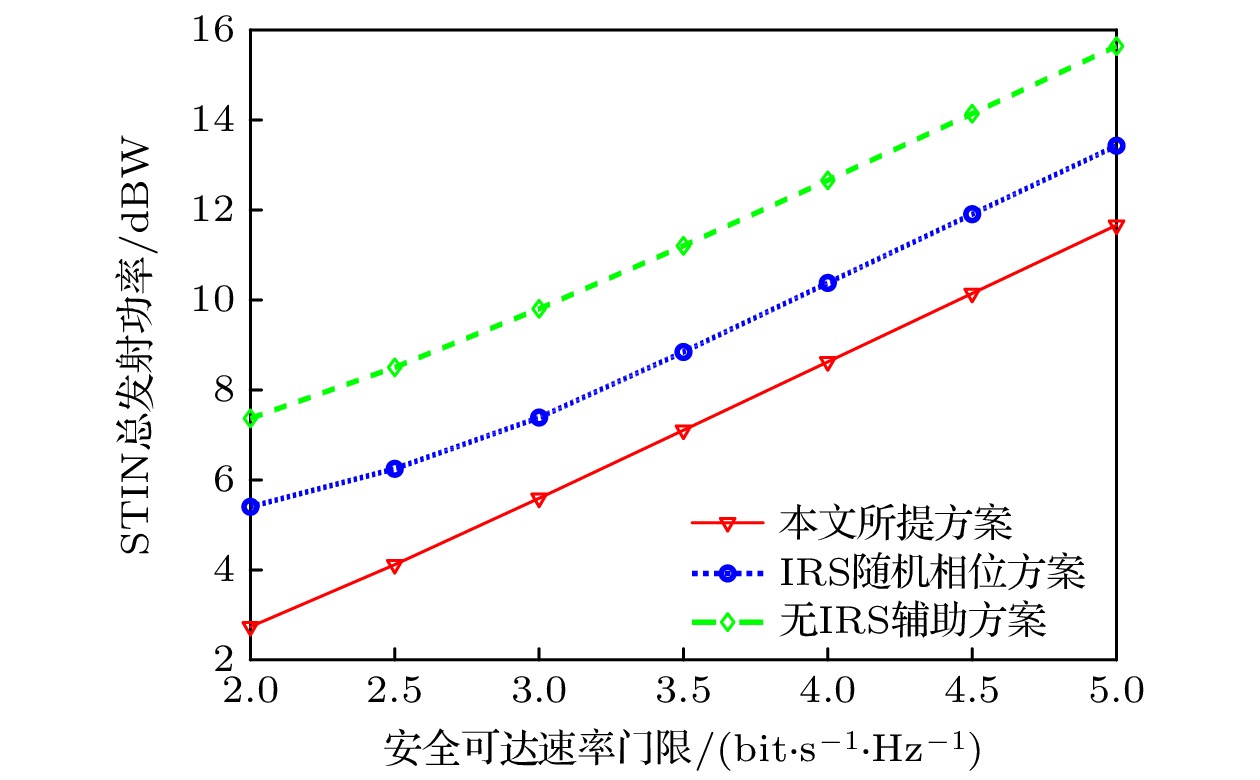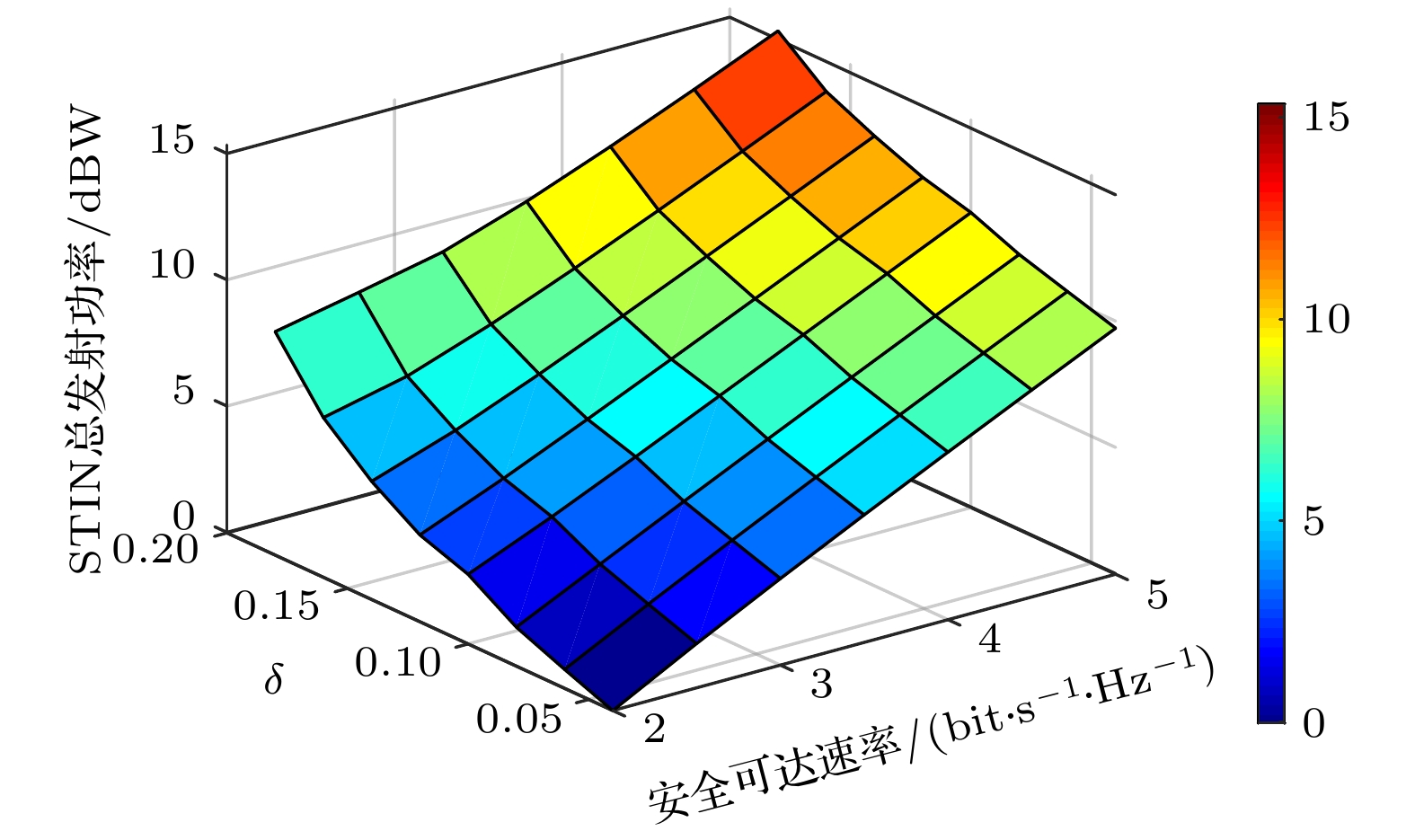-
For intelligent reflection surface (IRS) assisted satellite-terrestrial integrated network (STIN), a robust secure beamforming method based on the imperfect channel state information (CSI) of eavesdroppers is proposed. First of all, considering that the satellite uses spot beam technology to serve the earth station, while the ground base station (BS) serves multiple ground users through multicast technology, and in the case of frequency spectrum shared between the two networks, a joint optimization problem is formulated to minimize the total transmit power of STIN while satisfying the quality of service constraints of the BS users and the achievable secrecy rate constraints of the earth station. Secondly, in order to solve this non-convex problem, the upper bound and the lower bound of the eavesdroppers’ output signal-to-noise ratio under the condition of imperfect CSI are derived by employing triangle inequality together with Holder inequality. Then, a joint optimization scheme of robust BF and power control based on semi-positive definite programming and penalty function method is proposed to realize the secure and reliable transmission in STIN. Finally, the simulation results verify the effectiveness and superiority of the proposed algorithm.
-
Keywords:
- satellite-terrestrial integrated network /
- intelligent reflecting surface /
- robust beamforming /
- imperfect channel state information
[1] Huang Q Q, Lin M, Zhu W P, Cheng J, Alouini M S 2021 IEEE Trans. Commun. 69 2413
 Google Scholar
Google Scholar
[2] Lin Z, Lin M, Cola T D, Wang J B, Zhu W P, Cheng J 2021 IEEE Internet Things J. 8 11123
 Google Scholar
Google Scholar
[3] Kong H C, Lin M, Zhu W P, Amindavar H, Alouini M S 2020 IEEE Wireless Commun. Lett. 9 1235
 Google Scholar
Google Scholar
[4] Huang Q Q, Lin M, Zhu W P, Chatzinotas S, Alouini M S 2020 IEEE Trans. Aerosp. Electron. Syst. 56 2718
 Google Scholar
Google Scholar
[5] Lin M, Lin Z, Zhu W P, Wang J B 2018 IEEE J. Sel. Areas Commun. 36 1017
 Google Scholar
Google Scholar
[6] 刘笑宇, 林敏, 王金元, 欧阳键, 黄清泉 2019 68 292
 Google Scholar
Google Scholar
Liu X Y, Lin M, Wang J Y, Ouyang J, Huang Q Q 2019 Acta Phys. Sin. 68 292
 Google Scholar
Google Scholar
[7] 朱江, 王雁, 杨甜 2018 67 7
 Google Scholar
Google Scholar
Zhu J, Wang Y, Yang T 2018 Acta Phys. Sin. 67 7
 Google Scholar
Google Scholar
[8] 张海洋, 黄永明, 杨绿溪 2015 64 395
 Google Scholar
Google Scholar
Zhang H Y, Huang Y M, Yang L X 2015 Acta Phys. Sin. 64 395
 Google Scholar
Google Scholar
[9] Liu C, Feng W, Chen Y, Wang C X, Ge N 2020 IEEE Wireless Commun. Lett. 9 276
 Google Scholar
Google Scholar
[10] Lin Z, Lin M, Wang J B, Cola T D, Wang J 2019 IEEE J. Sel. Top. Signal Process. 13 657
 Google Scholar
Google Scholar
[11] Lu W, An K, Liang T, Zheng G, Chatzinotas S 2021 IEEE Syst. J. 15 2382
 Google Scholar
Google Scholar
[12] Lin Z, Lin M, Zhu W P, Wang J B, Cheng J 2021 IEEE Trans. Cogn. Commun. Netw. 7 567
 Google Scholar
Google Scholar
[13] Wu Q Q, Zhang R 2020 IEEE Commun. Mag. 58 106
 Google Scholar
Google Scholar
[14] Huang C, Zappone A, Alexandropoulos G C, Debbah M, Yuen C 2019 IEEE Trans. Wireless Commun. 18 4157
 Google Scholar
Google Scholar
[15] Basar E, Renzo M D, Rosny J D, Debbah M, Zhang R 2019 IEEE Access 7 116753
 Google Scholar
Google Scholar
[16] Yuan J, Liang Y C, Joung J, Feng G, Larsson E G 2021 IEEE Trans. Commun. 69 675
 Google Scholar
Google Scholar
[17] Cui M, Zhang G, Zhang R 2019 IEEE Wireless Commun. Lett. 8 1410
 Google Scholar
Google Scholar
[18] Yang H, Xiong Z, Zhao J, Niyato D, Xiao L 2021 IEEE Trans. Wireless Commun. 20 375
 Google Scholar
Google Scholar
[19] Xu S, Liu J, Cao Y, Li J, Zhang Y 2021 IEEE Trans. Veh. Technol. 70 2007
 Google Scholar
Google Scholar
[20] International Telecommunication Union https://www.itu.int/rec/R-REC-S.465-6-201001-I/en [2021–11–01]
[21] Zhao B, Lin M, Cheng M, Zhu W P, Al-Dhahir N 2021 IEEE Commun. Lett. 25 2708
 Google Scholar
Google Scholar
-
表 1 联合优化算法流程
Table 1. Joint optimization algorithm.
基于惩罚函数的联合优化算法流程 步骤1 初始化计算精度$\varepsilon = {10^{ - 7}}$, 惩罚因子$ \rho = 2 $和$ \mu = 2 $, 迭代次数k=0. 步骤2 使用SDR方法求解优化问题P4, 获得的初始解记为$ {{\mathbf{W}}^{(k)}} $和$ {{\mathbf{V}}^{(k)}} $. 步骤3 计算$ {{\mathbf{W}}^{(k)}} $最大特征值$ {\lambda _{\max }}\left( {{{\mathbf{W}}^{(k)}}} \right) $和对应的特征向量${\mathbf{w}}_{\max }^{(k)}$; 计算$ {{\mathbf{V}}^{(k)}} $最大特征值$ {\lambda _{\max }}\left( {{{\mathbf{V}}^{(k)}}} \right) $和对应的特征向量${\mathbf{v}}_{\max }^{(k)}$. 步骤4 求解凸优化问题P6, 获得的最优解记为$ {{\mathbf{W}}^{(k{\text{ + 1}})}} $和$ {{\mathbf{V}}^{(k{\text{ + 1}})}} $. 步骤5 如果$ {{\mathbf{W}}^{(k)}} \approx {{\mathbf{W}}^{(k{\text{ + 1}})}} $, 则更新$ \rho {\text{ = 2}}\rho $; 如果$ {{\mathbf{V}}^{(k)}} \approx {{\mathbf{V}}^{(k{\text{ + 1}})}} $, 则更新$ \mu {\text{ = 2}}\mu $; 步骤6 更新迭代次数$ k = k + 1 $. 步骤7 如果满足收敛条件$ \left| {{\text{Tr}}\left( {{{\mathbf{W}}^{(k)}}} \right) - {\lambda _{\max }}\left( {{{\mathbf{W}}^{(k)}}} \right)} \right| + \left| {{\text{Tr}}\left( {{{\mathbf{V}}^{(k)}}} \right) - {\lambda _{\max }}\left( {{{\mathbf{V}}^{(k)}}} \right)} \right| \leqslant \varepsilon $, 迭代结束, 输出W, V和P; 否则, 返回步骤3. -
[1] Huang Q Q, Lin M, Zhu W P, Cheng J, Alouini M S 2021 IEEE Trans. Commun. 69 2413
 Google Scholar
Google Scholar
[2] Lin Z, Lin M, Cola T D, Wang J B, Zhu W P, Cheng J 2021 IEEE Internet Things J. 8 11123
 Google Scholar
Google Scholar
[3] Kong H C, Lin M, Zhu W P, Amindavar H, Alouini M S 2020 IEEE Wireless Commun. Lett. 9 1235
 Google Scholar
Google Scholar
[4] Huang Q Q, Lin M, Zhu W P, Chatzinotas S, Alouini M S 2020 IEEE Trans. Aerosp. Electron. Syst. 56 2718
 Google Scholar
Google Scholar
[5] Lin M, Lin Z, Zhu W P, Wang J B 2018 IEEE J. Sel. Areas Commun. 36 1017
 Google Scholar
Google Scholar
[6] 刘笑宇, 林敏, 王金元, 欧阳键, 黄清泉 2019 68 292
 Google Scholar
Google Scholar
Liu X Y, Lin M, Wang J Y, Ouyang J, Huang Q Q 2019 Acta Phys. Sin. 68 292
 Google Scholar
Google Scholar
[7] 朱江, 王雁, 杨甜 2018 67 7
 Google Scholar
Google Scholar
Zhu J, Wang Y, Yang T 2018 Acta Phys. Sin. 67 7
 Google Scholar
Google Scholar
[8] 张海洋, 黄永明, 杨绿溪 2015 64 395
 Google Scholar
Google Scholar
Zhang H Y, Huang Y M, Yang L X 2015 Acta Phys. Sin. 64 395
 Google Scholar
Google Scholar
[9] Liu C, Feng W, Chen Y, Wang C X, Ge N 2020 IEEE Wireless Commun. Lett. 9 276
 Google Scholar
Google Scholar
[10] Lin Z, Lin M, Wang J B, Cola T D, Wang J 2019 IEEE J. Sel. Top. Signal Process. 13 657
 Google Scholar
Google Scholar
[11] Lu W, An K, Liang T, Zheng G, Chatzinotas S 2021 IEEE Syst. J. 15 2382
 Google Scholar
Google Scholar
[12] Lin Z, Lin M, Zhu W P, Wang J B, Cheng J 2021 IEEE Trans. Cogn. Commun. Netw. 7 567
 Google Scholar
Google Scholar
[13] Wu Q Q, Zhang R 2020 IEEE Commun. Mag. 58 106
 Google Scholar
Google Scholar
[14] Huang C, Zappone A, Alexandropoulos G C, Debbah M, Yuen C 2019 IEEE Trans. Wireless Commun. 18 4157
 Google Scholar
Google Scholar
[15] Basar E, Renzo M D, Rosny J D, Debbah M, Zhang R 2019 IEEE Access 7 116753
 Google Scholar
Google Scholar
[16] Yuan J, Liang Y C, Joung J, Feng G, Larsson E G 2021 IEEE Trans. Commun. 69 675
 Google Scholar
Google Scholar
[17] Cui M, Zhang G, Zhang R 2019 IEEE Wireless Commun. Lett. 8 1410
 Google Scholar
Google Scholar
[18] Yang H, Xiong Z, Zhao J, Niyato D, Xiao L 2021 IEEE Trans. Wireless Commun. 20 375
 Google Scholar
Google Scholar
[19] Xu S, Liu J, Cao Y, Li J, Zhang Y 2021 IEEE Trans. Veh. Technol. 70 2007
 Google Scholar
Google Scholar
[20] International Telecommunication Union https://www.itu.int/rec/R-REC-S.465-6-201001-I/en [2021–11–01]
[21] Zhao B, Lin M, Cheng M, Zhu W P, Al-Dhahir N 2021 IEEE Commun. Lett. 25 2708
 Google Scholar
Google Scholar
Catalog
Metrics
- Abstract views: 8172
- PDF Downloads: 108
- Cited By: 0















 DownLoad:
DownLoad:




